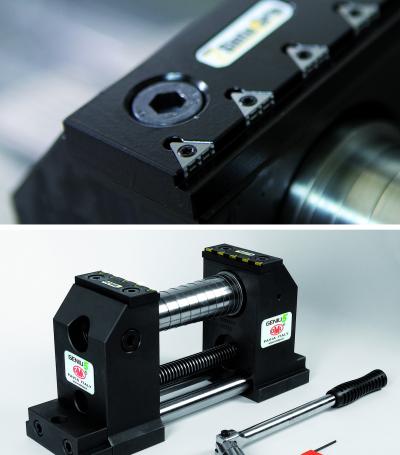
Fixtureworks has introduced its lineup of ultra-low profile TriGrip carbide gripper inserts and TriMax vises. TriGrip carbide gripper inserts are designed for ultralow profile 0.14 in. (3.5 mm) clamping with no dovetail workpiece preparation. These patented triangular grippers feature two rows of teeth at different angles with a 5 degree taper to maximize the pull-down effect, divide the clamping force, absorb vibration and allow for high stability and secure workholding. Already integrated with the TriMax line of vises, the TriGrip inserts are ideal for upgrading existing vise jaws and more.
With only 3.5mm of clamp surface needed to securely hold the workpiece, TriGrip workholding inserts are ideal for 5-axis machining operations. These durable inserts combine a tough-coated cemented carbide with specialized teeth and triangular shapes that penetrate materials including steel, hardened steel/titanium (up to 50-54 HRC) and aluminum.
TriGrip workholding inserts offer advantages over traditional clamping systems including exceptional clamping stability, no need for premachining or dovetailing workpieces, vibration dampening and allowing for very secure holding at lower clamping forces. This results in a higher cutting rate and less waste of materials than traditional clamping systems.
TriMax production vises help maximize a machine’s potential with multiple part clamping, quick change components and easy adjustment. The series of vises includes:
The TriMax G vise is designed for high precision 5-axis machine milling operations and can hold workpieces up to 7.87 in. (200 mm) in length. The vise allows for machining on five sides with just one clamping operation to provide dimensional stability, rigidity and durability for maximum cutting force and long life. TriMax G vises deliver up to 8,900 lb. of clamping force.
Designed to hold up to four workpieces at a time, TriMax C series of vises is a modular system with movable jaws that can be positioned along the vise body to handle a wide range of workpieces. Jaws and supports for TriMax C vises are available in three different widths: 38, 60 or 90 mm. Four base lengths are available in 250, 400, 500 and 630mm sizes.
The TriMax T Series of vises is a complete multi-part clamping system. Made to clamp up to four workpieces at a time, multiple movable jaw sets can be positioned along the vise base. TriMax T vises are available in widths of either 60 or 90 mm. Three base lengths are available: 400, 500 and 630 mm.
Improving on the standard machinist vise, the TriMax M system maximizes workholding combinations with minimal investment in equipment. TriMax M bases are offered in various lengths from 415mm to 878mm. A patented system allows for quick and easy repositioning of the clamping jaws, and for quick "snap-in" change of parallels, soft jaws and V-jaws.
Contact Details
Related Glossary Terms
- cutting force
cutting force
Engagement of a tool’s cutting edge with a workpiece generates a cutting force. Such a cutting force combines tangential, feed and radial forces, which can be measured by a dynamometer. Of the three cutting force components, tangential force is the greatest. Tangential force generates torque and accounts for more than 95 percent of the machining power. See dynamometer.
- gang cutting ( milling)
gang cutting ( milling)
Machining with several cutters mounted on a single arbor, generally for simultaneous cutting.
- milling
milling
Machining operation in which metal or other material is removed by applying power to a rotating cutter. In vertical milling, the cutting tool is mounted vertically on the spindle. In horizontal milling, the cutting tool is mounted horizontally, either directly on the spindle or on an arbor. Horizontal milling is further broken down into conventional milling, where the cutter rotates opposite the direction of feed, or “up” into the workpiece; and climb milling, where the cutter rotates in the direction of feed, or “down” into the workpiece. Milling operations include plane or surface milling, endmilling, facemilling, angle milling, form milling and profiling.






